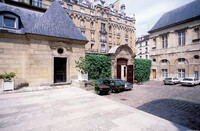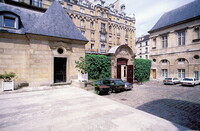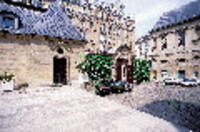| dc.coverage.spatial | Site: Paris, Île-de-France, France | en_US |
| dc.coverage.temporal | begun 1584 (creation) | en_US |
| dc.creator | Métezeau, Louis | en_US |
| dc.date | 1584 | en_US |
| dc.date.accessioned | 2013-01-25T21:26:07Z | |
| dc.date.available | 2013-01-25T21:26:07Z | |
| dc.date.issued | 1584 | en_US |
| dc.identifier | 186408 | en_US |
| dc.identifier.other | archrefid: 1651 | en_US |
| dc.identifier.uri | http://hdl.handle.net/1721.3/95602 | |
| dc.description | The Hôtel d’Angoulême, begun in 1584 for Diane d’Angoulême, Henry II’s illegitimate daughter, is attributed to Métezeau, and includes the city’s first example of a colossal order comprising large Corinthian pilasters, almost certainly inspired by one of Philibert de L’Orme’s plates in Le Premier Tome de l’architecture (1567; viii, fol. 252v). In 1658 Guillaume de Lamoignon (1617-1677) became president of the first parliament to sit in Paris. In the same year he bought the house in Rue Pavée (now the Hôtel de Lamoignon), property of the Angoulême family since 1584, and started to collect books, coins and medals. He was friendly with the most brilliant intellectuals of his day and was extolled by Nicolas Boileau in his poem Le Lutrin. Many famous people are associated with the building, including the architect Philibert Le Roy who lived there before 1631. It was purchased by the city of Paris in 1928 and became the Bibliothèque historique de la ville de Paris in 1969.; The Hôtel d’Angoulême, begun in 1584 for Diane d’Angoulême, Henry II’s illegitimate daughter, is attributed to Métezeau, and includes the city’s first example of a colossal order comprising large Corinthian pilasters, almost certainly inspired by one of Philibert de L’Orme’s plates in Le Premier Tome de l’architecture (1567; viii, fol. 252v). In 1658 Guillaume de Lamoignon (1617-1677) became president of the first parliament to sit in Paris. In the same year he bought the house in Rue Pavée (now the Hôtel de Lamoignon), property of the Angoulême family since 1584, and started to collect books, coins and medals. He was friendly with the most brilliant intellectuals of his day and was extolled by Nicolas Boileau in his poem Le Lutrin. Many famous people are associated with the building, including the architect Philibert Le Roy who lived there before 1631. It was purchased by the city of Paris in 1928 and became the Bibliothèque historique de la ville de Paris in 1969. Source: Grove Art Online; http://www.oxfordartonline.com/ (accessed 12/15/2008) | en_US |
| dc.format.medium | stone | en_US |
| dc.rights | © Scott Gilchrist, Archivision, Inc. | en_US |
| dc.subject | architectural exteriors | en_US |
| dc.subject | rulers and leaders | en_US |
| dc.subject | L’Orme, Philibert de, 1515?-1570 | en_US |
| dc.subject | Mannerist (Renaissance-Baroque style) | en_US |
| dc.subject | Sixteenth century | en_US |
| dc.title | Hôtel d'Angoulême Lamoignon | en_US |
| dc.title.alternative | Bibliothèque historique de la ville de Paris | en_US |
| dc.type | image | en_US |
| dc.rights.access | Licensed for educational and research use by the MIT community only | en_US |
| dc.identifier.vendorcode | 1A2-F-P-HL-B1 | en_US |
| vra.culturalContext | French | en_US |
| vra.technique | construction (assembling) | en_US |
| vra.worktype | hôtel (town house) | en_US |
| vra.worktype | library (building) | en_US |
| dc.contributor.display | attributed to Louis Métezeau (French architect, 1559-1615) | en_US |


